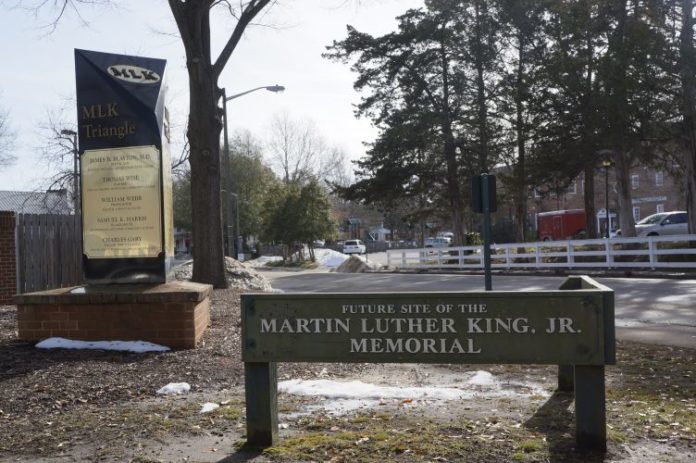Twenty years after Martin Luther King Jr. visited Williamsburg in 1962 and spoke to members of the first Baptist Church in the United States, a sign was placed at a nearby intersection stating that it would be the future site for his memorial. The monument’s planning has not made instrumental strides since the mid-1980s — until December 2017.
Williamsburg National Association for the Advancement of Colored People President Brian Smalls, Williamsburg Mayor Paul Freiling ’83 and Vice-Mayor Scott Foster’10 J.D. ’14 have discussed the beginning plans for the project. Born out of these talks was a consensus that the memorial should not be a unilateral project carried out only by the City, but rather a community project led by the people of Williamsburg.
I think that we all agree that in addition to building a monument, what we are looking for is an opportunity for community engagement,” Freiling said. “Through that process, more and more, we are hoping dialogue about issues of race and about society today.”
“I think that we all agree that in addition to building a monument, what we are looking for is an opportunity for community engagement,” Freiling said. “Through that process, more and more, we are hoping dialogue about issues of race and about society today.”
To encourage community participation in the memorial’s planning, the three leaders have also agreed to develop a committee to lead the project.
“One of things that came out of that initial meeting was [that] we need to put together a committee to actually get the community involved because obviously this [is] going to be a community memorial,” Smalls said. “So, the community needed to play a role in what this project was going to look like.”
Since the initial talks, City Manager Marvin Collins and attorney John Garley have joined the project.
Rather than solely honoring King, the memorial will also recognize key local civil rights leaders and business owners who played an instrumental role during the civil rights era in Williamsburg.
The sign’s location, at the intersection of Scotland and Prince George streets, is where their businesses once stood.
“There’s a consensus seems to be is that it shouldn’t just a memorial to Dr. King — that should be a component of it — but it should also honor many of the black business owners that came up during the time of segregation,” Smalls said. “Where the sign is currently, that area is known as the Triangle, and that was the hub of black businesses pre-civil rights and through the civil rights era, up until the late ’70s and early ’80s.”
While the project in still in its early stages, it has been supported by larger community organizations. Freiling said that the Triangle Arts and Culture League is interested in possibly funding the project, in addition to a financial contribution by the City Council.
Despite the long wait for the memorial since the 1980s, Freiling is committed to seeing the project to fruition. While Foster wants the memorial completed in 2019, Freiling will consider the project a success if the community sees groundwork finished that same year.
“Especially as we are approaching the 400th anniversary of the arrival of the first enslaved African to Jamestown in 1618 … if we don’t do it now, I don’t know when we are going to do it,” Freiling said.
He said he also recognizes the large generational gap between King’s time and that of the children of Williamsburg.
“No kid in school today was alive when Dr. King was alive,” Freiling said. “So how many of them know about him? How many of them understand the context of times within which he lived and try to enact the change he was seeking through nonviolent means? When we don’t consistently reinforce history, we run the risk of losing it.”
Foster’s commitment to the project’s revival stems from the events that took place in Charlottesville, Virginia, Aug. 11-12.
Part of it was born out of what went on in Charlottesville,” Foster said. “I thought we needed to, as a city, move forward to recognize the importance of our African-American community. There’s a great story here in the African-American community that needs to be better understood by the general public.”
“Part of it was born out of what went on in Charlottesville,” Foster said. “I thought we needed to, as a city, move forward to recognize the importance of our African-American community. There’s a great story here in the African-American community that needs to be better understood by the general public.”
Alexa Mason ’19, co- president of the College of William and Mary’s NAACP chapter, said she hopes that all of the community members contributing to the memorial consider the lasting impact the memorial could have on Williamsburg.
“As a chapter [of the NAACP], we hope that the memorial is constructed with the care and attention to detail as fitting of someone of Dr. King’s stature,” Mason said in an email. “We are excited that the memorial is coming to fruition after a long period of planning, and hope that the monument will inspire this generation of young leaders to continue King’s fight against discrimination, voter suppression, and other civil rights violations.”

